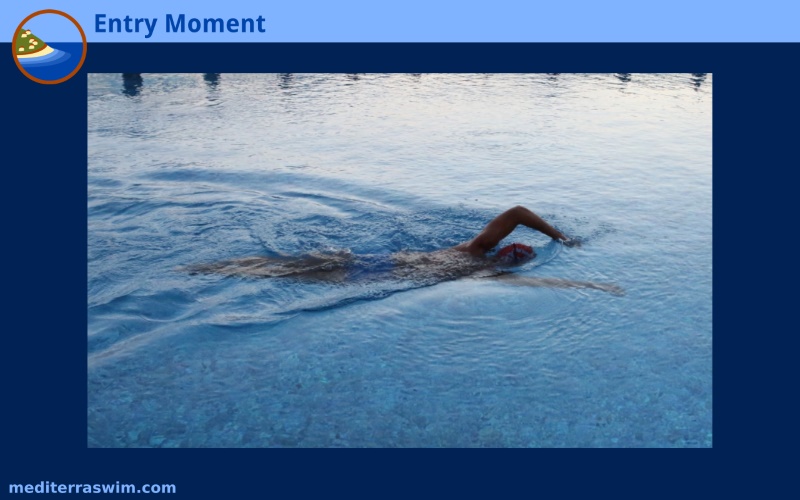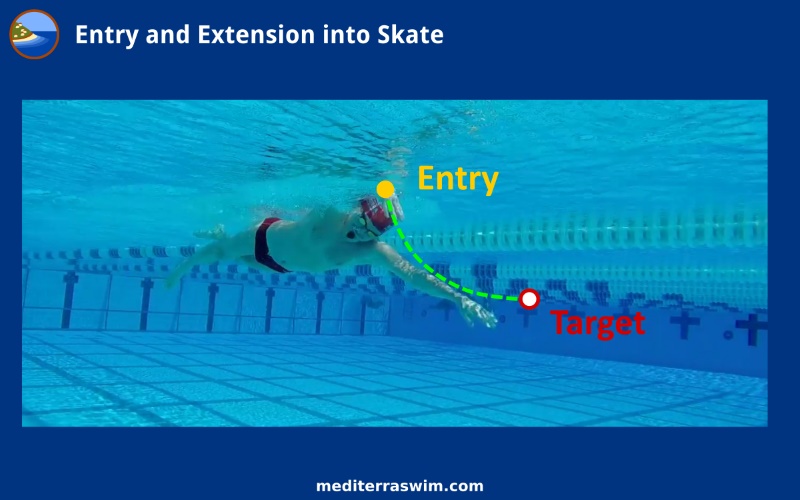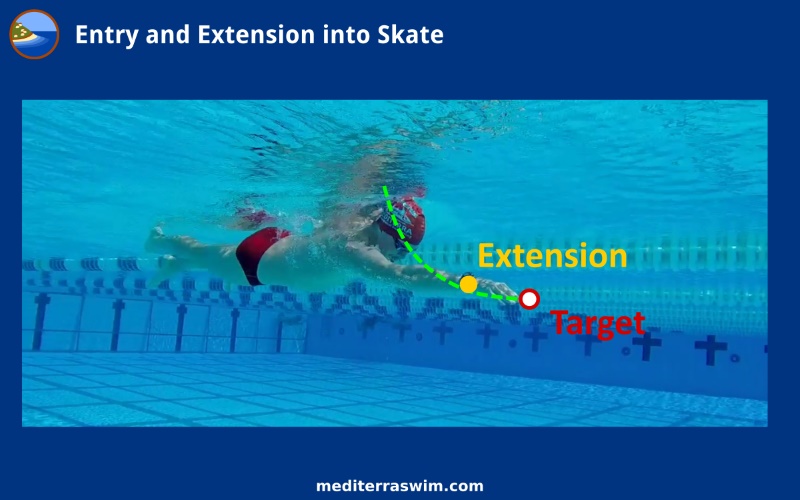Forums › Library › Swim Course Instructions › Entry and Extension Introduction
Please type your comments directly in the reply box - DO NOT copy/paste text from somewhere else into the reply boxes - this will also copy the code behind your copied text and publish that with your reply, making it impossible to read. Our apology for the inconvenience, but we don't see a convenient way of fixing this yet.
Tagged: entry, extension, propulsion, skate, synchronization, target
-
AuthorPosts
-
January 2, 2018 at 11:15 #16676
Admin Mediterra
KeymasterEntry and Extension Introduction
The entry and extension into Skate is how you deliver force into forward motion. The hand enters at a certain location, near the head, in front of the shoulder. It drives down into the water steeply, like traveling down the start of an Olympic ski jump. Then the arm begins to extend underwater, and its path levels out as it reaches target depth, straight in front of that shoulder. Then the arm continues to extend and reach, piercing the target, which brings your body into its best Skate Position. Your body is lengthening and becoming more streamline with each microsecond. In this way, you receive the three forces from the recovery arm momentum, from gravity, and from the catch and convert all that into acceleration.

Below is an outline for how we form the entry and extension, and you will find some additional focal points and diagrams on the 101 Focal Points page under the Entry And Extension section.
The entry has a certain timing, a particular pathway and a certain smooth speed to make it most effective. The better your Entry and Extension into your best Skate Position, the more that force is transferred into forward motion.
Let us reiterate this again so that it sinks in: The whole emphasis of the stroke is to Send Force Forward through the Recovery + Entry + Extension into Skate. Everything else, including the catch, supports this primary action of sending the vessel of your body forward. This is the finish of the freestyle stroke. Treat this section of the stroke cycle as the important moment everything else has been preparing for.
Instructions

The forearm begins to enter close to the head, in front of the shoulder, with a steep angle, as if driving downward… at first. You are only going to start at a steep angle, but it will not stay this way.

Remember, the goal is to Send Force Forward, the arm must be underwater as it extends toward the target. This requires an early entry position and a steep entry angle so that the arm can harness the rotational force of the torso into parting water molecules in front of the body.

The arm drives down, on a curving path, to target depth and then levels out as it aims to pierce the target. The hand should come to a depth just below the lowest point of the body line. Notice that the emphasis of the lead arm is to stretch forward, not downward.
Notice how long and straight the body is on the Skate side. The swimmer is fully extended and continuing to emphasize the reach. He is not ‘twisting’ into an over-rotated position in order to reach. The side of the body is lengthening, as if he was going to pierce the target with his wrist.
Drills Useful For Entry Practice
- Standing rehearsal to create entry arm shape
- Recovery Swing, One Arm (swing to Entry Position and dip it a few times)
- 1-Arm Slot To Skate (standing, with one arm in entry position, fall forward into Skate)
- 2- Arm Slot To Skate (standing, with one arm in entry position, and one arm in Skate Position, fall forward and switch arms, slide into Skate)
Entry Focal Points
- Elbow high above ear
- Elbow swings forward as far as comfortable
- Feel the stretch in the back as you reach entry position
- Forearm aiming straight ahead on track
- Forearm angling down (45 degree, like ski jump)
- Hand entry position across from opposite (lead arm) elbow)
Extension Pathway Focal Points
- ‘Ski jump’ shape entry path
- Slide down to target depth and forward
- Spear wrist through your target
-
AuthorPosts
- You must be logged in to reply to this topic.
